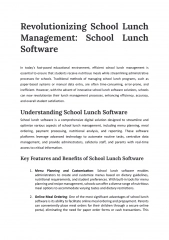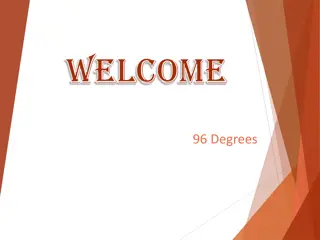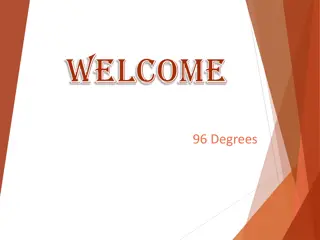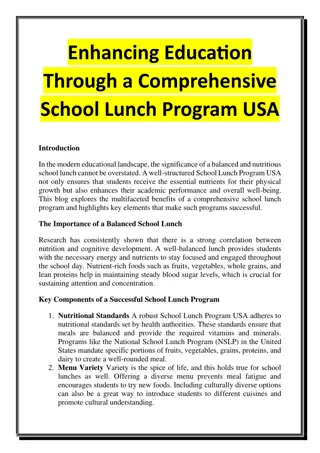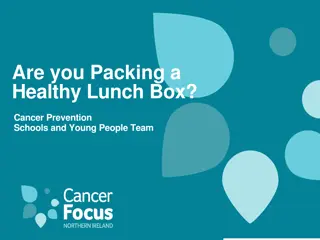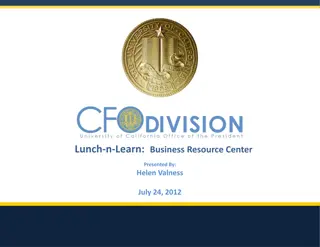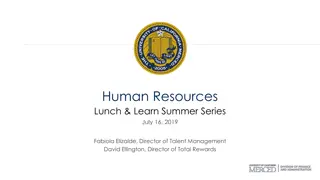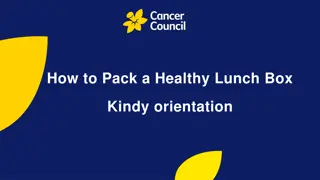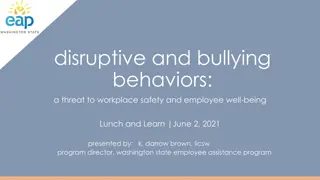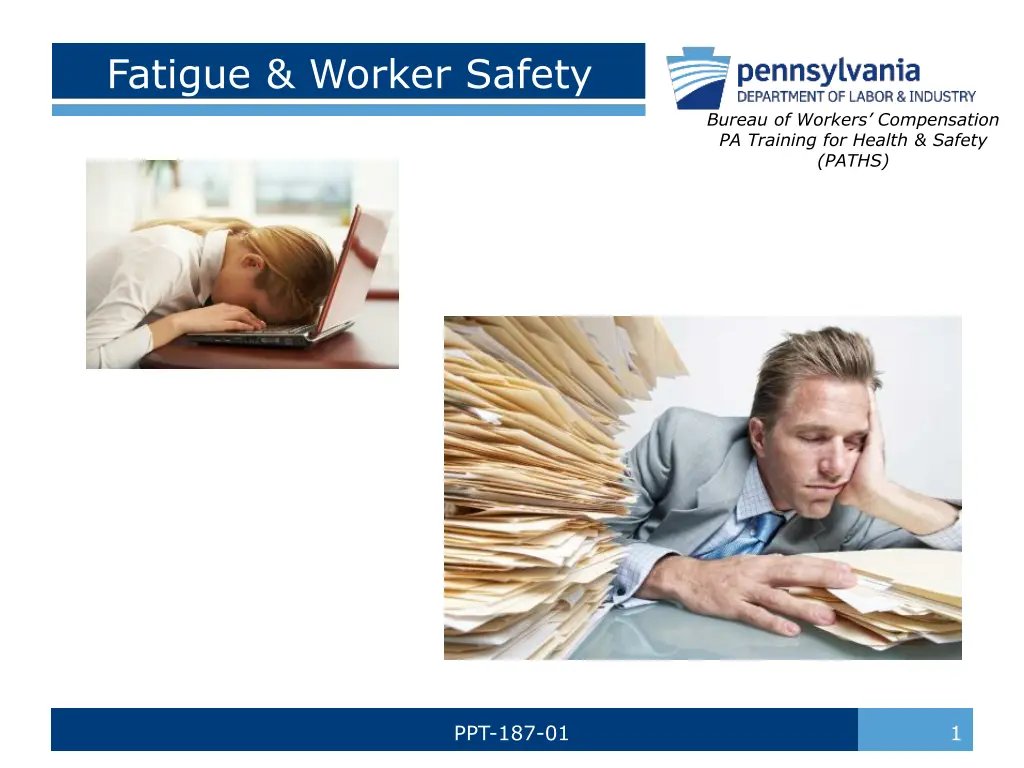
Understanding Fatigue in Workplace
Learn about the definition, causes, effects, and solutions for fatigue in the workplace. Understand the difference between physical and mental fatigue, its impact on worker safety, industries at higher risk, and ways to manage fatigue effectively.
Uploaded on | 1 Views
Download Presentation

Please find below an Image/Link to download the presentation.
The content on the website is provided AS IS for your information and personal use only. It may not be sold, licensed, or shared on other websites without obtaining consent from the author. If you encounter any issues during the download, it is possible that the publisher has removed the file from their server.
You are allowed to download the files provided on this website for personal or commercial use, subject to the condition that they are used lawfully. All files are the property of their respective owners.
The content on the website is provided AS IS for your information and personal use only. It may not be sold, licensed, or shared on other websites without obtaining consent from the author.
E N D
Presentation Transcript
Fatigue & Worker Safety Bureau of Workers Compensation PA Training for Health & Safety (PATHS) PPT-187-01 1
Overview Definition Causes & Effects Statistics Solutions Risk Management PPT-187-01 2
Definition Fatigue The body s response to sleep deprivation or lengthy physical or mental hard work.* *American College of Occupational & Environmental Medicine PPT-187-01 3
Physical Fatigue Physical fatigue or muscle fatigue is the temporary physical inability of a muscle to perform optimally. PPT-187-01 4
Mental Fatigue Mental fatigue is the temporary inability to maintain optimal cognitive performance. PPT-187-01 5
Fatigue vs Sleepiness Fatigue is generally considered a more long-term condition than sleepiness. Sleepiness is the tendency to fall asleep; fatigue is the body s response to sleep loss or prolonged physical or mental exertion. PPT-187-01 6
Causes & Effects Causes Long work hours Heavy workloads Lack of sleep Environmental factors Medical conditions Multiple jobs PPT-187-01 7
Causes & Effects Causes Mental stress Overstimulation Understimulation Jet lag Depression Active recreation Boredom PPT-187-01 8
Causes & Effects Effects Slower reaction time More errors/mistakes Decreased cognitive ability PPT-187-01 9
Industries Fatigue can occur in all industries; however, some industries have higher risks: Shift workers Health care Drivers Industries with long work hours Industries with overtime Industries that expose workers to harsh environmental conditions PPT-187-01 10
Environmental Conditions Weather Noise Vibrations Heavy mental task loads for long periods of time PPT-187-01 11
Statistics Estimated annual injury incidence per 100 workers Usual hrs. slept/day 7.89 < 4.99 5-5.99 6-6.99 5.21 3.62 2.27 7-7.99 2.50 8-8.99 2.22 9-9.99 4.72 > 10 PPT-187-01 12
Statistics 38% of U.S. workers sleep less than 7 hours a night.* Workers who have a sleeping disorder are more likely to be involved in a workplace safety incident.* Fatigue-related productivity losses cost almost $2,000 per worker each year.# * According to NIOSH # According to Cupertino, CA-based Alertness Solutions PPT-187-01 13
Statistics Lack of sleep results in a 13% increased risk of death.* Lack of sleep results in the loss of 1.2 million workdays per year.* * RAND Corporations PPT-187-01 14
Solutions Taking breaks Adopting better sleep habits Understand the importance of sleep; promote it Create brighter workplaces with settings for naps Deter lengthy use of electronic devices after work PPT-187-01 15
More Solutions Working during the day rather than at night Restricting consecutive day shifts to five or six days and night shifts to four days Ensuring workers have at least two consecutive days off Making schedules consistent Providing frequent breaks PPT-187-01 16
Signs Supervisors should be alert for signs of excessive fatigue such as: Yawning Head dropping Difficulty remembering or concentrating PPT-187-01 17
Risk Management Reporting of fatigue-related incidents Investigation Training for employees on fatigue and managing sleep disorders Auditing Are sleep disorders covered on the insurance plan? PPT-187-01 18
Risk Management Taking breaks Caffeine Changing environmental factors Do not consume alcohol before bedtime Moving safety-sensitive work to other employees or another time to take advantage of alertness PPT-187-01 19
Risk Management Improve lighting Minimizing humidity Minimizing monotonous noise Minimizing vibration Making sure the temperature is cooler especially at night PPT-187-01 20
Risk Management Balancing workload and staffing Shift scheduling Workplace design/redesign Monitoring of fatigue PPT-187-01 21
Training Fatigue related hazards Sleep disorders Diet Exercise How to get adequate and quality sleep How to recognize fatigue PPT-187-01 22
Getting a Good Nights Sleep Tips for getting a good night s sleep 1. Repay your debt - The lack of enough sleep over time can result in a sleep debt. This is the difference between the amount of sleep you need and the amount you get. This debt can be repaid by tacking on extra time each night until you feel caught up. PPT-187-01 23
Getting a Good Nights Sleep 2. Exercise by Day to Sleep at Night - Regular exercise can help you sleep better. For best results, exercise outside before dinner. But don't rev up with exercise near bedtime. In the evening, light yoga or stretches can help you wind down. If you have a medical problem or are over 50 check with your doctor before starting an exercise routine. PPT-187-01 24
Getting a Good Nights Sleep 3. Choose Evening Snacks Wisely - An oatmeal raisin cookie and a glass of milk can help you fall asleep. That's because this snack includes complex carbs that likely increase levels of sleep- inducing amino acid tryptophan. Other sleep- boosting choices: a piece of whole grain toast or a small bowl of cereal. PPT-187-01 25
Getting a Good Nights Sleep 4. Get on a Sleep Schedule - The average person needs 7-9 hours of sleep per night. Most experts recommend maintaining a consistent sleep schedule even on days when you can sleep in. This balances a person's internal clock, allowing them to stay awake when needed and fall asleep when ready. It helps if your bedroom is conducive to sleep: dark, cool, and quiet. PPT-187-01 26
Getting a Good Nights Sleep 5. Wind Down Your Brain - Try blocking out a daily "worry time" to get anxiety out of your system before bed. Make time just after dinner to plan your next day, catch up on email, and tie up loose ends. Then you can have time before bed to let go of anxieties and relax. PPT-187-01 27
Getting a Good Nights Sleep 6. If You Nap, Keep it Short - Whether you should nap during the day depends on how you normally sleep at night. If you typically sleep well, then an occasional short nap is OK. Naps can make you function better, lower blood pressure, and maybe even help you live longer. Avoid napping too late in the day, as it might affect your nighttime sleep. But if you have sleep problems, naps may mess up your sleep schedule even more. PPT-187-01 28
Getting a Good Nights Sleep 7. Avoid Hidden Sleep Wreckers - Caffeine can perk you up so avoid it after lunch if you have trouble sleeping at night. It can stay in your system for an average of three to five hours, but some people are affected for as much as 12 hours. Watch your afternoon food and drink choices. Caffeine may hide in soft drinks, tea, and chocolate. Also be wary of certain medications, such as decongestants, which can aggravate sleep problems. PPT-187-01 29
Getting a Good Nights Sleep 8. Natural Ways to Help You Sleep - Some people try natural methods to wind down their day. Used medicinally for thousands of years, chamomile brewed in tea is non-caffeinated and may help relax you for sleep. Or try aromatherapy. Studies have found that lavender produces slight relaxing and calming effects when inhaled. For some people, melatonin seems to improve sleep. If you take medications, talk with your doctor before taking any supplement. PPT-187-01 30
Getting a Good Nights Sleep 9. Try Relaxation Exercises - In the late evening, visualize something calming, using all your senses to make the image as vivid as possible. Or try progressive muscle relaxation. Tighten up the muscles in your toes for several seconds. Then relax them for 30 seconds. Focus on how relaxed they feel. Repeat this all the way up your body, ending at your neck and face. PPT-187-01 31
Getting a Good Nights Sleep 10. When You're in Pain - You may want to consider taking a nighttime pain reliever to help you doze off, but consult your doctor if pain commonly keeps you up at night. PPT-187-01 32
Getting a Good Nights Sleep See a Doctor About Sleep Problems If you have sleep problems and none of these strategies helps, you may have a sleep disorder. Medications and some medical conditions can cause sleep problems. Your doctor or a sleep specialist can help you find the problem and learn ways to improve sleep. PPT-187-01 33
Contact Information Health & Safety Training Specialists (717) 772-1635 RA-LI-BWC-PATHS@pa.gov Upcoming PATHS Webinars Upcoming PATHS Webinars Request for Topic Resources Request for Topic Resources PPT-187-01 34
Questions PPT-187-01 35
IUP OSHA Consultation Program Telephone Number 1-724-357-4095 Link to website for more information on the Indiana University of Pennsylvania's OSHA Consultation Program. Link for additional information Link for additional information Link for additional information PPT-187-01 36
PennOSHS Program Link to website for the Pennsylvania Occupational Safety Health Surveillance Program. Link to website for Link to website for additional information additional information Link to website for additional information Link to website for additional information Link to website for additional information Link to website for additional information PPT-187-01 37
Pennsylvanias GASE Award Emblem for the Pennsylvania Governor's Award for Safety Excellence. Are you proud of your safety program? Apply from January 1st to May 1st to be recognized for our state s highest safety honor. Does it go above and beyond? If so, we want to hear from you. Link for additional information Link for additional information PPT-187-01 38
Bibliography Safety & Health Magazine National Safety Council March 2017. Wikipedia https://en.wikipedia.org/wiki/Fatigue_(medical) WebMD http://www.webmd.com PPT-187-01 39
Related Presentations If you are interested in viewing more information regarding worker fatigue we suggest the following PowerPoints which we can send you or you can find on our website: Stress and Worker Safety Drug and Alcohol Awareness http://www.dli.pa.gov/Businesses/Compensation/ WC/safety/paths/Pages/default.aspx PPT-187-01 40


